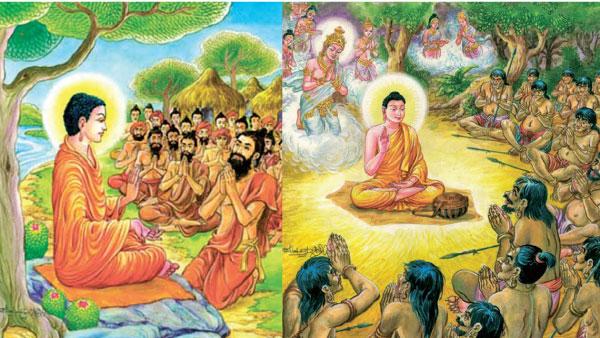
Poya days are sacred days for Budhists. In Sri Lanka people began to observe Poya and participate in religious activities after Arahath Mahinda brought Buddhism to Sri Lanka during the reign of King Devanampiyatissa. Poya is based on the waxing and waning of the moon. The full moon day is the Pura Paslosvaka or main Poya day. One reason that the Poya is based on the moon maybe because in ancient times there were no calendars available.
According to the calendar we use today there are twelve full moon days for the year, that is one Poya day each for every month.This is because the full moon days are counted according to the course taken by the moon. Sometimes, there can be 13 Poyas in an year and the extra Poya will be called the Adhi Poya.
Though the English Calendar (Gregorian) shows January as the first month of the year the Sinhala calendar takes April or Bak as the first month of the year. So the twelve months and Poya days in Sinhala are: January - Duruthu, February – Navam, March – Medin, April- Bak, May – Vesak, June – Poson, July - Esala, August – Nikini, September – Binara, October – Wap, November – Il, December – Unduvap.
Of the Poya’s Vesak is very important to Buddhists, as the Gautama Buddha was born, became enlightened or became the Buddha and attained Nirvana on this day.
Duruthu Poya
The Duruthu Poya is important to Sri Lankans as it was on a Duruthu Poya that Gautama Buddha visited Sri Lanka for the first time. This was nine months after he attained Buddhahood. He came here to prevent a fierce war between two groups of Yakshas who inhabited this island. He saw this himself and decided to prevent it.
The Yakshas were gathered at a place called Mahiyangana (Miyuguna). He wanted to preach the Dhamma to them and to make them understand their foolishness. The Yakshas were hostile and the Buddha had to subjugate or tame them first. He radiated Budu Ras, a halo of colours and the Yakshas were cowed. It is also said that the Buddha used rain, thunder, a gale and a drought to subdue the Yakshas. Then he preached the Dhamma.
One legend says the Yakshas were sent to Giri Divaina after this while another says the Yakshas who did not understand the Dhamma fled to Giri Divaina.
The Devas or Gods had also come to hear the Buddha preach at Mahiyangana and after he preached to the Yakshas the Buddha preached to the Gods. God Sumana Saman who lived on the Sammanthakuta mountain had asked the Buddha for an object to worship and he had given him a lock of hair (Kesha Dathu).
God Saman had built a dagoba at Mahiyangana enshrining the sacred relic of hair.
Later Arahath Sarabu is said to have rebuilt the dagoba enshrining the Greeva Dathu or the sacred relic of the Buddha’s collar bone. Successive Kings had reconstructed the Dagoba with Culabhaya, King Devanampiyatissa’s brother increasing the Dagoba’s height to 30 lengths.
King Dutugamunu had raised the height of the Mahiyangana Dagoba to 80 feet.
It was also during the month of Duruthu that King Bimbisara of Magadha offered the Veluvanaramaya to the Buddha.
